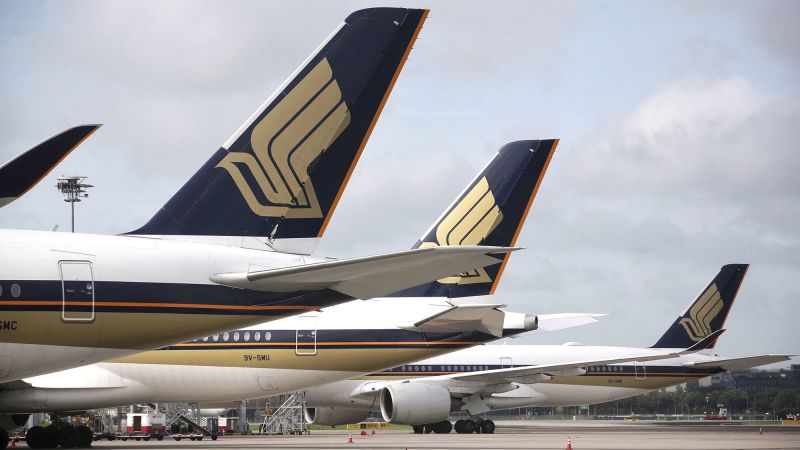Fatal Turbulence on Singapore Airlines Flight
- May 23, 2024 04:01am
- 265
One passenger has died and at least 71 others were injured when a Singapore Airlines flight from London to Singapore encountered severe turbulence. The plane was carrying 228 passengers and 19 crew members.

The Airbus A380 aircraft was flying over the Indian Ocean when it hit a patch of severe turbulence. The plane dropped suddenly, causing passengers and crew to be thrown around the cabin.
One passenger, a 47-year-old Singaporean man, was killed in the incident. He was seated in an economy class seat near the rear of the plane.
At least 71 other passengers and crew members were injured, including 12 who were seriously hurt. The injured were taken to hospitals in Singapore for treatment.
Singapore Airlines said in a statement that the plane landed safely at Changi Airport in Singapore at 6:15 a.m. local time.
The airline said it is "deeply saddened" by the death of the passenger and is providing assistance to his family.
The cause of the turbulence is under investigation.
In a statement, the Air Transport Safety Bureau (ATSB) said it is "aware of the incident" and is "gathering information."
The ATSB is responsible for investigating aviation accidents and incidents in Australia.
The Singapore Airlines flight was the second in recent weeks to encounter severe turbulence.
On October 31, a United Airlines flight from Chicago to Honolulu was forced to make an emergency landing in San Francisco after hitting a patch of severe turbulence.
That incident resulted in 36 injuries, including 11 that were serious.
The two incidents have raised concerns about the safety of air travel.
Some experts say that severe turbulence is becoming more common due to climate change.
"As the atmosphere warms, the jet stream is becoming more erratic," said Jeff Masters, a meteorologist with the Weather Underground. "This is leading to more frequent and intense bouts of turbulence."
Other experts say that the increase in air travel is also contributing to the problem.
"There are simply more planes in the air, which increases the chances of hitting a patch of turbulence," said John Cox, a former airline pilot and safety consultant.
The International Air Transport Association (IATA) said in a statement that it is "aware of the concerns about turbulence" and is "working with airlines and regulators to improve safety."
The IATA said that turbulence is a "natural phenomenon" and that there is no way to completely eliminate it.
However, the IATA said that there are steps that airlines can take to reduce the risk of injuries from turbulence.
These steps include:
* Using weather radar to track turbulence and avoid it if possible
* Training pilots to deal with turbulence
* Providing passengers with information on how to stay safe during turbulence
The IATA said that passengers can also take steps to reduce their risk of injuries from turbulence.
These steps include:
* Wearing a seat belt at all times during a flight
* Keeping loose items stowed away
* Avoiding walking around the cabin during turbulence
Related articles
-
Arsenal Continue Unbeaten Streak with Convincing Victory Over Southampton Arsenal extended their impressive unbeaten run to 16 games with a comfortable 3-0 win over Southampton at Emirates Stadium on Saturday. Goals from...
- 06 Oct 2024
-
 Former Memphis Police Officers Convicted in Fatal Beating of Tyre Nichols
Following a nearly two-year-long trial, five former Memphis police officers have been found guilty of murder and other charges in the brutal beating...
Former Memphis Police Officers Convicted in Fatal Beating of Tyre Nichols
Following a nearly two-year-long trial, five former Memphis police officers have been found guilty of murder and other charges in the brutal beating...
- 05 Oct 2024
-
 Halle Bailey and DDG Separate: A Love Story Ended
After welcoming their first child together, singer Halle Bailey and rapper DDG have decided to part ways. The news of their split comes as a surprise...
Halle Bailey and DDG Separate: A Love Story Ended
After welcoming their first child together, singer Halle Bailey and rapper DDG have decided to part ways. The news of their split comes as a surprise...
- 05 Oct 2024
-
 Texas Police Chief Ambushed, Manhunt Intensifies
A Texas police chief was ambushed on Tuesday night, leaving him in critical condition. A suspect is still at large, and a massive manhunt is...
Texas Police Chief Ambushed, Manhunt Intensifies
A Texas police chief was ambushed on Tuesday night, leaving him in critical condition. A suspect is still at large, and a massive manhunt is...
- 05 Oct 2024
-
 The Master of the Macabre: A One-Man Play Explores the Enigma of Edgar Allan Poe
Delve into the enigmatic depths of Edgar Allan Poe in a captivating one-man play that brings the legendary writer to life. Broadway and film veteran...
The Master of the Macabre: A One-Man Play Explores the Enigma of Edgar Allan Poe
Delve into the enigmatic depths of Edgar Allan Poe in a captivating one-man play that brings the legendary writer to life. Broadway and film veteran...
- 04 Oct 2024
-
Desperate Plea for a Miracle: Cuban Reggaeton Icon El Taiger Battles for Survival Renowned Cuban Reggaeton artist El Taiger is clinging to life at Ryder Trauma Center after sustaining a severe gunshot wound to the head. Authorities...
- 04 Oct 2024

Leave a comment
Your comment is awaiting moderation. We save your draft here
0 Comments
Chưa có bình luận nào